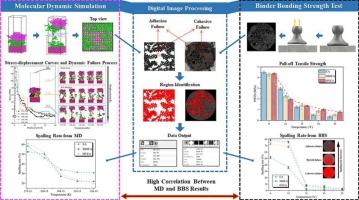当前位置:
X-MOL 学术
›
Appl. Surf. Sci.
›
论文详情
Our official English website, www.x-mol.net, welcomes your
feedback! (Note: you will need to create a separate account there.)
Exploring the bonding and debonding behaviors of emulsified asphalt-aggregate interface using molecular dynamic simulation and binder bonding strength test
Applied Surface Science ( IF 6.3 ) Pub Date : 2025-04-11 , DOI: 10.1016/j.apsusc.2025.163236
Wenyi Xu , Jie Yuan , Xin Qiu , Kangfeng Zheng , Shanglin Xiao , Yingci Ye , Qing Yang
Applied Surface Science ( IF 6.3 ) Pub Date : 2025-04-11 , DOI: 10.1016/j.apsusc.2025.163236
Wenyi Xu , Jie Yuan , Xin Qiu , Kangfeng Zheng , Shanglin Xiao , Yingci Ye , Qing Yang

|
This study aims to explore the bonding and debonding behaviors of emulsified asphalt-aggregate interface coupling molecular dynamic (MD) simulations and binder bonding strength (BBS) tests. Firstly, the adhesion and cohesion properties of three modified asphalt were analyzed. Secondly, the debonding behaviors including tensile strength and interfacial failure mode were investigated. Finally, the correlation between MD and BBS tests was verified. The results demonstrate that the incorporation of polymer modifiers enhances the self-cohesive interaction, thus improving the interfacial stability and resistance to high temperature erosion. The viscoelasticity of emulsified asphalt determines the interfacial debonding behaviors at different temperatures. At low temperatures, all emulsified asphalt shows excellent bonding capacity and obvious brittle elasticity, leading to the appearance of adhesive failure at the interface. In opposite, cohesive failure occurs inevitably in high temperatures since viscous characteristics dominate the properties. However, the high temperature resistance of SBS modified emulsified asphalt (SBSEA) and high viscoelastic modified emulsified asphalt (HVEA) is better than that of emulsified asphalt (EA). Besides, there exists strong correlation between molecular simulation and experimental tests. In general, EA is recommended for applications at medium and low temperatures while SBSEA and HVEA are better suited for pavement situations susceptible to high temperature damage.
中文翻译:

利用分子动力学模拟和粘结剂粘结强度测试探究乳化沥青-骨料界面的粘结和脱粘行为
本研究旨在探讨乳化沥青-骨料界面耦合分子动力学 (MD) 模拟和粘结剂粘结强度 (BBS) 测试的粘结和脱粘行为。首先,分析了三种改性沥青的粘结和内聚性能;其次,研究了包括拉伸强度和界面破坏模式在内的脱粘行为;最后,验证 MD 和 BBS 检验之间的相关性。结果表明,聚合物改性剂的掺入增强了自粘性相互作用,从而提高了界面稳定性和抗高温侵蚀性。乳化沥青的粘弹性决定了不同温度下的界面脱粘行为。在低温下,所有乳化沥青都表现出优异的粘结能力和明显的脆性弹性,导致界面处出现粘结失效。相反,在高温下不可避免地会发生内聚破坏,因为粘性特性占主导地位。然而,SBS 改性乳化沥青 (SBSEA) 和高粘弹性改性乳化沥青 (HVEA) 的耐高温性能优于乳化沥青 (EA)。此外,分子模拟和实验测试之间存在很强的相关性。一般来说,EA 推荐用于中低温应用,而 SBSEA 和 HVEA 更适合易受高温损坏的路面情况。
更新日期:2025-04-11
中文翻译:

利用分子动力学模拟和粘结剂粘结强度测试探究乳化沥青-骨料界面的粘结和脱粘行为
本研究旨在探讨乳化沥青-骨料界面耦合分子动力学 (MD) 模拟和粘结剂粘结强度 (BBS) 测试的粘结和脱粘行为。首先,分析了三种改性沥青的粘结和内聚性能;其次,研究了包括拉伸强度和界面破坏模式在内的脱粘行为;最后,验证 MD 和 BBS 检验之间的相关性。结果表明,聚合物改性剂的掺入增强了自粘性相互作用,从而提高了界面稳定性和抗高温侵蚀性。乳化沥青的粘弹性决定了不同温度下的界面脱粘行为。在低温下,所有乳化沥青都表现出优异的粘结能力和明显的脆性弹性,导致界面处出现粘结失效。相反,在高温下不可避免地会发生内聚破坏,因为粘性特性占主导地位。然而,SBS 改性乳化沥青 (SBSEA) 和高粘弹性改性乳化沥青 (HVEA) 的耐高温性能优于乳化沥青 (EA)。此外,分子模拟和实验测试之间存在很强的相关性。一般来说,EA 推荐用于中低温应用,而 SBSEA 和 HVEA 更适合易受高温损坏的路面情况。







































 京公网安备 11010802027423号
京公网安备 11010802027423号